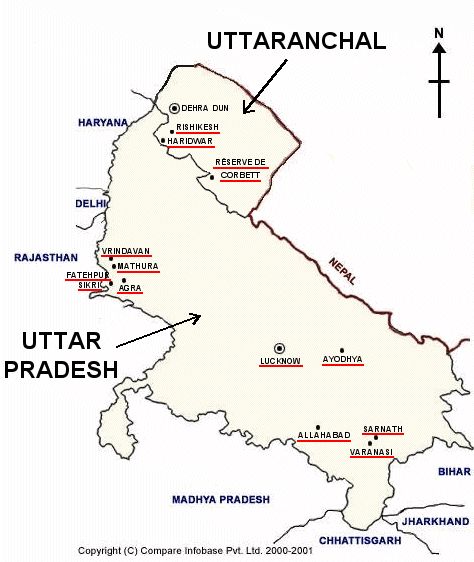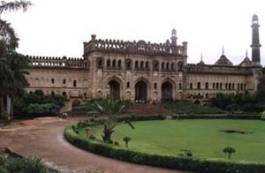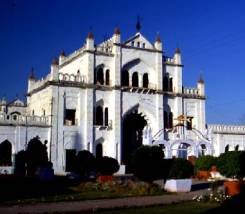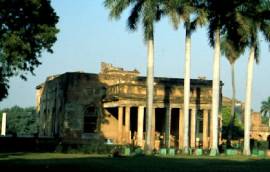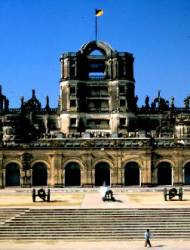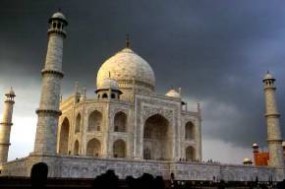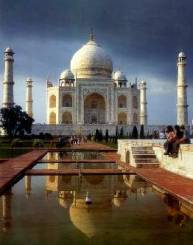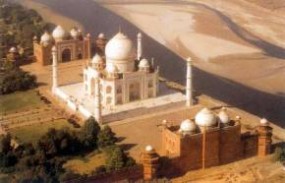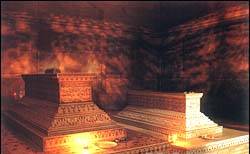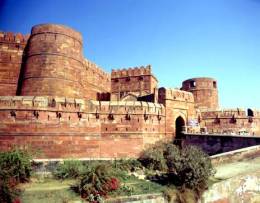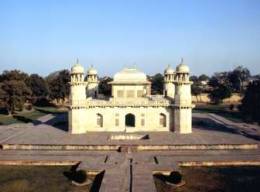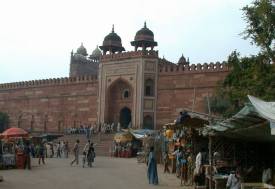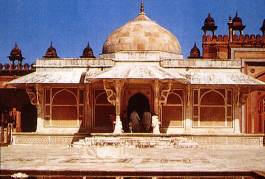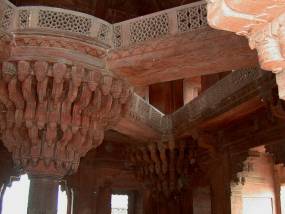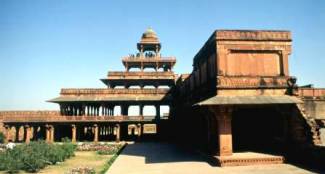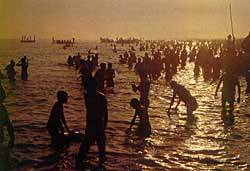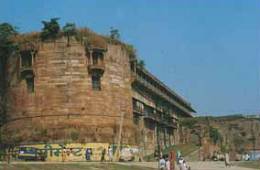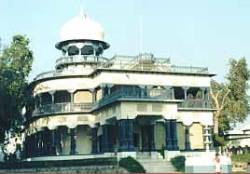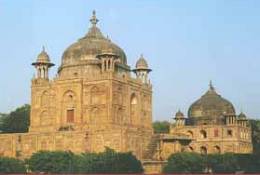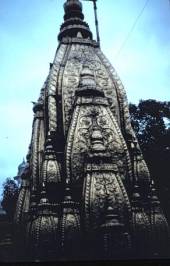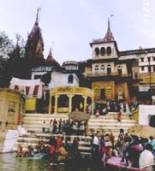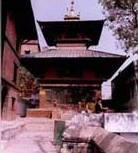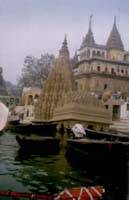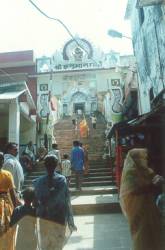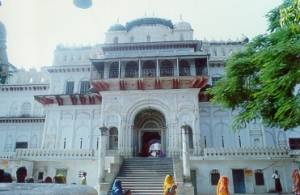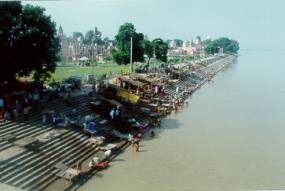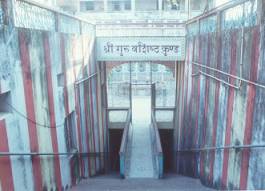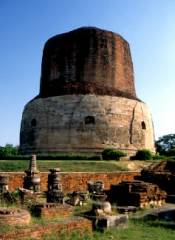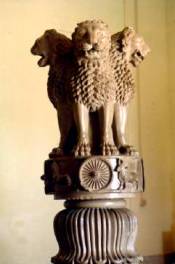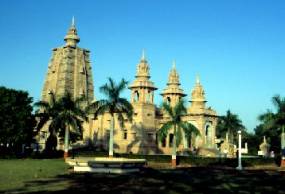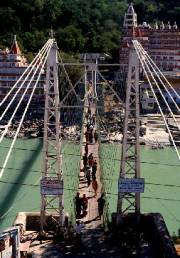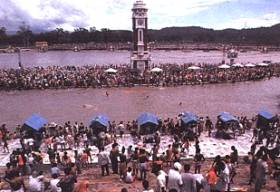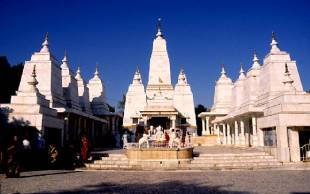Uttar Pradesh is the historical, spiritual and political heart of Northern India. Historical because the great empires have always installed their capitals in this region, spiritual because there are many holy cities of Hinduism and Buddhism and political because most Indian politicians were born there. Uttar Pradesh is the most populous Indian state (166 million inhabitants). Its capital is Lucknow and the official language is Hindi. The Ganges, the backbone of Uttar Pradesh, flows from north to south along a fertile plain often dramatically flooded during the monsoon.
This state is the breadbasket of India since it produces 19% of the country's cereals and is the largest producer of milk and sugar. If it is highly developed from an agricultural point of view, Uttar Pradesh singularly lacks energy resources for its industry.
Located in northern Uttar Pradesh, Uttaranchal was created in November 2000 after several decades of claims. With its 9 million inhabitants, its capital is Dehra Dun.
History
The history of this region goes back more than 2000 years. In the fourth century BC Buddhism and Jainism made their appearance there. At the same time King Ashoka annexed the region to make it the center of the Maurya kingdom. In the 4th century AD, Uttar Pradesh was controlled by Chandragupta before being divided into several small kingdoms. In 1206 the sultanate of Delhi was created and Uttar Pradesh naturally formed part of it. The whole was integrated into the Mughal empire in the sixteenth century. Delhi, Agra and Fatehpur Sikri were in turn the capital of the kingdom. After the decline of the Mughals, the nawabs of Avadh (Lucknow) controlled the area with being deposited by the English just before the revolt of the sepoys in 1857.
The province was officially dubbed Uttar Pradesh (state of the north) at independence in 1947. In November 2000 the northern state was amputated to endorse the creation of Uttaranchal.
Carte de l'Uttar Pradesh et de l'Uttaranchal
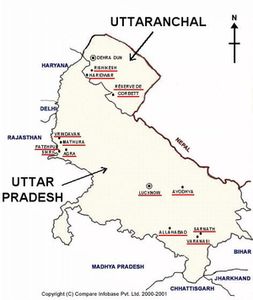
Map of Uttar Pradesh and Uttaranchal
Lucknow
Formerly called Oudh, or Avash, Lucknow is today the capital of the state of Uttar Pradesh. Its foundation goes back to the 13th century with the construction of a fort that will be disputed by the local powers until its annexation by the Mughal emperor Akbar. In 1724 Muhammad Shah appointed the nabob Burhan-ul-Mulk governor of the city. He was the first nabob of a dynasty that did not end until 1856 with the arrival of the English.
In 1857 the sepoys of the English armies revolted. The English settlers and the troops took refuge inside the Residence. The siege lasted 87 days and caused several hundred deaths among the besieged.
Lucknow is known for its cuisine, reminiscent of Mughal presence. A large festival of kites and a famous Indian music and dance festival are held in the city every year. From a tourist point of view Lucknow offers few attractions and is heavily polluted.
The Bara Imambara
Built in 1784 by the fourth nabob, Asaf-ud-Daula, Bara Imambara is the most famous monument of Lucknow. (An Imambara designates the tomb of a holy Muslim man). Its construction began during a famine, the nabob having promised food in exchange for the works. The main hall measures 50 meters long by 15 wide without any pillars to support its roof. On the first floor is a labyrinth, the Bhool Bhullaiyya.
Near the main building is a baoli (a well) connected to the river by tunnels in which, according to legend, one would have discovered fabulous treasures. Within the same complex are the Rumi Darwaza (picture), or Turkish Gate, supposedly a replica of a door in Istanbul; the 67-meter High Clock Tower erected in 1880 by the English; and a mosque and its two minarets.
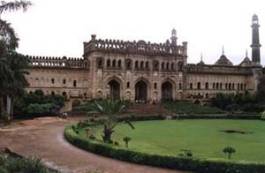
The Bara Imambara
The Hussainabad Imambara
Built in 1837 by Mohammed Ali Shah to serve as a mausoleum, this building is also called Chota Imambara, or Palace of Lights because of the candlesticks lit during the festival of Muharram. The entrance is surmounted by a golden dome and the courtyard has a raised basin around which there are two imitations of the Taj Mahal.
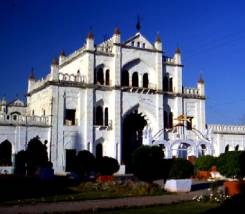
The Hussainabad Imambara
The residence
This name was simply given to the residence placed at the disposal of the English governor after its construction in 1800. The Residence was the theater of a siege which lasted 87 days during the revolt of the sepoys in 1857. 3000 English found there refuge but only 1000 survived before the reinforcements arrived. The walls were left untouched and still bear the stigma of the battle. Inside is a museum.
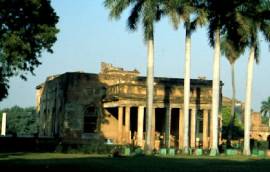
The residence
The school la Martinière
This former palace was the residence of French General Claude Martin. He had been imprisoned by the English in Pondicherry before being appointed by the East India Company to go and fight the troops of Mysore. He settled in Lucknow to negotiate an alliance with the nabob. He drew his own residence, an improbable mixture of European and Indo-Muslim architecture. Martin died there in 1800. Today, and in accordance with the last wishes of French, the building is a private school.
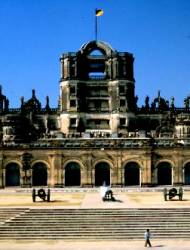
The school la Martinière
Agra
Built on the Gulf of Bengal, Mamallapuram (formerly Mahabalipuram) was the great port city of the Pallava (5th-8th). She also derives her name from one of the Pallava kings, Mamalla. Compared to large cities, Mamallapuram resembles a village (14,000 inhabitants). The city stretches between its beach and a rocky promontory on which were built many small temples.
The peace, the cultural richness of the site and the proximity of the beach make of Mamallapuram a pleasant and relaxing stage. The local artisans are essentially sculptors and have made the city famous in this matter.
The Taj Mahal
The Taj Mahal is a tourist symbol of India, a World Heritage Site, and does not impair its status as a world wonder.
The construction of this marble masterpiece is due to the Mughal emperor Shah Jahan who built it after the death in bed of his wife Mumtaz Mahal in 1630. The work lasted 17 years, from 1632 to 1648 and mobilized 20,000 artisans. It is said that the best of them had their hands cut off to prevent them from reproducing such a masterpiece. They used white marble, red sandstone, crystal, precious and semi-precious stones.
The site has three entrances, one to the south, one to the east and one to the west. The large red sandstone door (30 meters high) which is to the south served as the main entrance. It is adorned with verses from the Koran in Arabic. Today is an exit, the entrance is through a small door on the right. Between the gate and the Taj itself are ornamental gardens of Mughal style divided by canals. A small museum was built to the west of the gardens. You can see the original plans of the architects and an explanation of the construction.
The Taj Mahal rises on a platform at the corners of which stand four minarets 41.6 meters high (their role is purely decorative). The main dome measures 44.4 meters high and is surrounded by four small cupolas. The interior of the mausoleum consists of a high central hall, an underground crypt and four octagonal rooms in the corners originally intended to receive the tombs of other members of the family. In the center are the cenotaphs of Mumtaz Mahal and Shah Jahan. They are delicately encrusted with semi-precious stones. That of the emperor is greater than that of his wife on which were engraved inscriptions in Persian. Perforated marble panels surround them.
On each side of the Taj Mahal, two twin buildings of red sandstone were erected. The one to the west is a mosque, the eastern one being there only to ensure the symmetry of the whole and has no religious utility.
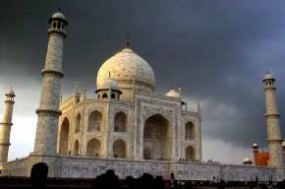
The Taj Mahal
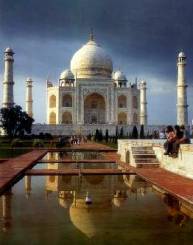
The Taj Mahal
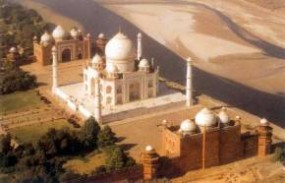
The Taj Mahal
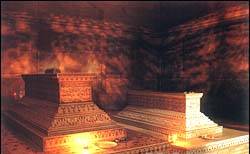
The Taj Mahal
The red fort of Agra
This imposing red sandstone fort was built between 1565 and 1573 by the Mughal emperor Akbar. It was the residence of three sovereigns: Akbar, Shah Jahan and Aurangzeb. It was in this fort that Aurangzeb locked up his father Shah Jahan after overthrowing him. The walls are 2.5 km long and about 20 meters high. One enters the fort by the Amar Singh, the only access point open to the public. Inside several buildings deserve a visit:
- The palace of Jahangir: It is the most residence of the fort. It was built by Akbar for his son Jahangir. From then on, the fort was no longer merely a military square but also a place of residence. The architecture is mainly of Hindu style, the Mughal style will assert itself later under Shah Jahan.
- The Diwan-i-Khas: It is the pavilion of the private audiences built by Shah Jahan in 1636. The emperor received the high foreign dignitaries there. The famous Peacock throne was there before being transported to Delhi by Aurangzeb.
- Diwan-i-Am: This is the Public Hearing Pavilion built by Shah Jahan in 1628. Three rows of pillars support the flat roof. It was here that the Emperor listened to the grievances of the people surrounded by curtains and silk carpets. A door leads to the "ladies' bazaar" which owes its name to the merchants who came to present their goods to the women of the nobility.
- Mussaman Burj: This is a two-story octagonal tower in which Shah Jahan was locked up until his death. From there he had a view of the Taj Mahal.
- Moti Masjid: This is the private mosque of the Mughal emperors built between 1646 and 1653 by Shah Jahan. A Persian inscription on the inside compares it to a perfect pearl. A nice basin of ablutions is in the center of the courtyard.
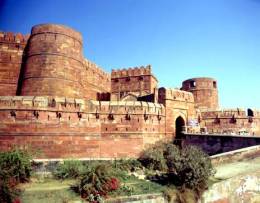
The red fort of Agra
The Itimad-Ud-Daulah
It is the tomb of Mirza Ghiyas Beg, father-in-law of Emperor Jahangir. Its construction began in 1622 and ended in 1628. Its architecture recalls that of the Taj Mahal. It was also the first building of this type built in marble and it is here that the craftsmen developed the technique of inlaying precious stones in the marble widely used for the Taj.
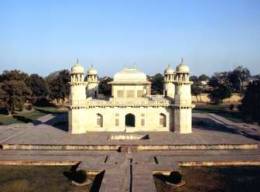
The Itimad-Ud-Daulah
Fatehpur-Sikri
In 1568 the Mughal emperor Akbar went to the small village of Sikri to visit a holy Muslim man named Salim Chisti. Akbar despaired of having a male heir. The saint predicted the birth of a son if his wife came to settle in the village. The prediction was realized in 1569. Akbar then decided to build a city and make it its capital. It was christened Fatehpur Sikri (City of Victory) after the conquest of Gujarat by the Mughal troops. In 1585 Akbar abandoned the place and never returned. The city emptied itself completely to become a ghost town. Remains the superb monuments of red sandstone of Mughal style.
The Jama Masjid
This mosque built in 1571 would be the copy of that of Mecca. It measures 168 meters by 144 meters and has a large inner courtyard. The main entrance is through a 54 meter high gate, the Buland Darwaza, erected after Akbar's victory on the Gujarat. The other entrance, the Shahi Darwaza, was that borrowed by the king.
Inside is the marble tomb of Saint Salim Chisti. It is overhung by a dome. The tomb itself is surrounded by delicately perforated marble panels. Even today women who wish to have a child come here and pray to the saint.
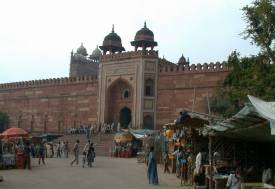
The Jama Masjid
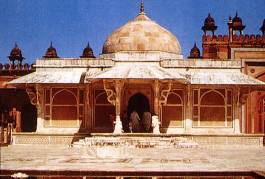
The Jama Masjid
The Diwan-I-Khas
This pavilion is also called Maison des Bijoux. It rises on two levels but the interior is composed of only one piece in the center of which is a large pillar 2 meters high supporting a throne from which four stone bridges link the corners of the room . It is not clear what interpretation to give to this structure.
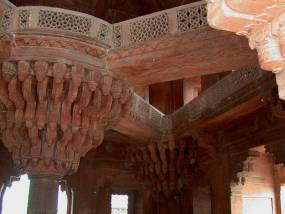
The Diwan-I-Khas
The Panch Mahal
The smallest construction of the complex, the Panch Mahal is a palace of four floors whose size decreases the more you climb. The ground floor is 22 meters by 18 meters. The top floor is occupied by a kiosk. The building is supported by 185 columns in total of which 84 on the ground floor all different. The Panch Mahal served as apartments for the women of the royal family.
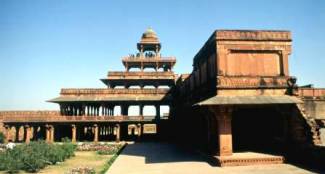
The Panch Mahal
The Diwan-I-Am
It is the pavilion of the public hearings in which the sovereign took the time to listen to the complaints of his subjects. Nearby is a paved courtyard, the Pachisi, in which the emperor played the chaubar, a kind of chess game whose pawns were female slaves.
The palace of Jodh Bai
This palace of Hindo-Muslim style owes its name to the mother of Jahangir, son of Akbar. It is located at the place that once was the entrance to the city. It has a Hawa Mahal (Palace of Winds) which is a wall pierced with a multitude of windows in clear sky allowing the women to look outside without being seen. The palace adjoins the "Christian wife" dwelling so called because it served as the residence of the Christian wife of Akbar. In the time of the splendor of Fatehpur Sikri this building was completely gilded.
The Ankh Michauli
This building served the emperor to play hide-and-seek with the women of the harem! More seriously some historians think that it served as a deposit for the treasure of Akbar.
Mathura and Vrindavan
Mathura is a great center of Hindu pilgrimage because it is here that Krishna would be born. The city is known since antiquity since Ptolemy cited it in the 2nd century under the name of Madura (City of the Gods). Under Ashoka, the Buddhist monasteries were numerous but they disappeared little by little in the face of Hinduism. In 1017 Mahmud of Ghazni pillaged the city and destroyed the Hindu and Buddhist temples. It was once again sacked by Aurangzeb and then by Ahmad Shah Durrani in 1757. Today there are few ancient Hindu structures.
Vrindavan is the neighboring town of Mathura. Krishna grew up there with the gopis (the cowherds). The city has many temples and like Mathura it attracts many pilgrims.
At Mathura
The Sri Krishna Janmabhoomi
On this site stands the temple of Kesava Deo built around a small room in which Krishna was born 3,500 years ago. According to legend, King Kansa had locked up his sister and husband, fearing a prophecy that their son would cause his death. A prophecy which did not fail to be realized. Today thousands of pilgrims. crowd in this temple.
On the same site is the mosque of Aurangzeb. This proximity between Hindus and Muslims makes the place is very watched especially since the inter-communal clashes of Ayodhya.
The temple of Dwarkadheesh
It is the largest temple of Mathura. It was built in 1814 by Seth Gokuldass and dedicated to Krishna. There are magnificent sculptures and paintings. A great activity reigns during the Hindu feasts of Holi and Janmashtami.
The Sati Burj
Built on the banks of the Yamuna River, this four-storey tower was erected by the son of Bihari Mal of Jaipur after his mother's satiation (ritual immolation on her husband's pyre). The upper floors are not original because Aurangzeb had destroyed them.
The Gaths
The ghats are the stairs that dive into the river and serve for the ritual baths of the Hindus. The most important is the Vishram Ghat because it was here that Krishna rested after killing King Kansa. Every evening, the faithful put into the water small oil lamps carried away by the current.
At Vrindavan
The temple of Radha Madana-Mohana
This temple was founded by Srila Sanatana Gosvami at the time when Vrindavan was a forest. It is the oldest temple in the city. The effigy of the divinity was carried to Rajasthan to save it from the fanatical attacks of the Mughal emperor Aurangzeb.
The temple of Jaipur
It was inaugurated by the maharaja of Jaipur, Sawai Madhav, in 1917 after 30 years of work. The maharaja financed the work of the temple but also of the railway line which was used to bring the building materials to Vrindavan. The large pillars that support the roof are monolithic.
The Ghat of Kesi
It was at this place that Krishna killed the demon Kesi appeared in the form of a horse. Krishna would then have taken a purifying bath in the river.
The temple of Rangaji
This temple was built in 1851 by the Seth family and dedicated to Rangaji. This name refers to the form of Krishna lying on the serpent Sesa Naga. This temple has a gopuram in the image of the temples of southern India and is surrounded by high walls. A pillar covered with gold stands in the holy of holies.
Allahabad
The city lies at the confluence of two sacred rivers of Hinduism: the Yamuna and the Ganges. The mythical Saraswati River would join them here too. Allahabad is one of the great centers of pilgrimage of India. Every 12 years the Kumbh Mela stands here (see the city of Nasik for an explanation of the Kumbh Mela). The last Kumbh Mela of Allahabad took place at the beginning of 2001. Allahabad is referenced in many ancient texts, it was then called Prayag. Brahma, creator of the Universe, would have practiced a ritual sacrifice. Archaeological research has proved the presence of a city organized in 1100 BC. Chinese travelers made the description in the 7th century. In 1193 it was annexed to the sultanate of Delhi. In 1584 it was renamed Allahabad (Abode of Allah) by the Mughal emperor Akbar.
The British made it their headquarters for the North-West provinces. It was here, in 1858, after the revolt of the sepoys, that the Indian Company yielded power to the British Crown. Allahabad is famous for his university nicknamed "the Oxford of the East".
The Sangam
C'est l'endroit où la Yamuna, le Gange et la mythique Saraswati se rejoignent. Tous les ans, en janvier-février, un pèlerinage (le Magh Mela) a lieu sur les rives. Le plus important de tous (le Kumbh Mela) revient tous les douze ans. Ce dernier rassemble plusieurs millions de personnes en quelques semaines. Se baigner ici permet de se purifier de tous ses péchés et immerger les cendres d'un défunt lui permettra d'atteindre la moshka, c'est-à-dire la libération du cycle des réincarnations.
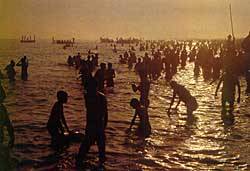
The Sangam
The fort
It is one of the largest forts built by the Mughal Akbar. Built near Sangam in 1583, it has thick walls and three doors flanked by high towers. The fort passed successively into the hands of the Mughals, the marathons, the pathans, and the British. It is now owned by the army and largely inaccessible to the public. Visitors can see the underground temple of Patalpuri where the immortal tree (Akshaiveta) is located and the temple of Hanuman in which the monkey god is shown lying. Inside the reserved enclosure is an 11-meter-high Ashoka column dating from 232 BC
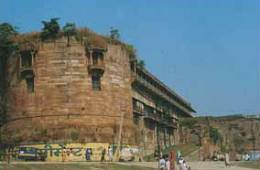
The fort
The Anand Bhawan
This building was formerly the home of the Nehru family. India Gandhi donated it to the Indian government in 1970, which turned it into a museum. There are many objects that belonged to the family and the rooms where some of the most important figures in modern India lived. A permanent photographic exhibition in the beautiful garden traces the life and political work of Jawaharlal Nehru.
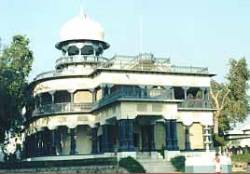
The Anand Bhawan
The Khusru Bagh
This is the mausoleum of Prince Kushru. This was the son of the Mughal Emperor Jehangir. He revolted against his father and was executed by his brother Shah Jahan. Next to it stood the empty tomb planned for his sister and the tomb of his mother.
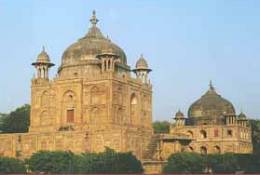
The Khusru Bagh
Varanasi
Varanasi (formerly Benares) is one of the seven holy cities of Hinduism. Bathing in the Ganges in Varanasi is supposed to purify from all sins and to be incinerated on the ghats allows to free oneself from the cycle of reincarnations.
Its current name comes from two rivers, the Varuna and the Assi. In the past the city was called Kashi and Benares. Its name is mentioned in sacred Hindu and Buddhist texts and it was on the route of travelers from Central Asia and China. It would be one of the oldest cities in the world. It has a very special atmosphere, so life and death rub shoulders with every corner of the street. Today the city is also known for its silk and its saris.
The temple of Vishwanath
The date of construction of this temple dedicated to Shiva (Vishveswara) is not known, but it is at least 1300 years old since it is quoted by the Chinese monk Huien Tsang in the 7th century. The temple was destroyed and rebuilt several times, notably by the Mughal Aurangzeb. The present structure was erected in 1777 by Ahilya Bai Holkar of Indore. In 1835 the maharaja Ranjit Singh supplies the 800 kilos of gold that now cover his dome 15.5 meters high, which earned him the nickname "golden temple." Not far from the temple is the Gyan Kupor well whose water is supposed to lead to a higher level of consciousness.
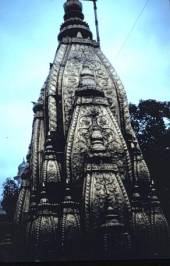
The temple of Vishwanath
The Gaths
The ghats are the steps that plunge into the river and serve for the ritual baths of the Hindus. Some ghats are reserved for the cremation of the dead. There are a hundred ghats along the Ganges. The pilgrims accomplish the Panchatirthi Yatra which consists in going to bathe in five ghats in a very precise order. These ghats are the Assi Ghat, the Dashaswamegh Ghat, the Manikarnika Ghat, the Panchganga Ghat and the Adi Kesava Ghat. Many ghats are worth a visit. Access is generally allowed to non-Hindus but be as discreet as possible if you take photos of the faithful.
Assi Ghat: It is the southernmost ghat of the city, it is at the confluence of the Ganges and the Asi which confers its sacred character.
Dasaswamedh Ghat: It is one of the main ghats of Varanasi. Brahma would have sacrificed 10 horses (dasa-asva-medha) in order to allow the Shiva city. Several temples are located at the top of the ghat.
Manikarnika Ghat: Undoubtedly one of the oldest ghats of cremation of the city. It is here that most of the dead are burnt. At the top of the steps is the manikarnika well. It derives its sacred character from a legend that Shiva (or Parvati) would have dropped a ring in this location. He then dug a hole to retrieve it. Not far from this well is a slab on which Vishnu would have left footprints.
Panchganga Ghat: It would be built at the confluence of five rivers: the Ganges, the Yamuna, the Saraswati, the Kirna and the Dhupapapa but only the Ganges really exists there. Many festivals take place here during the year. The faithful light oil lamps which they place on a large column.
Adi Kesava Ghat: Located at the confluence of the Varuna and the Ganges, this ghat would be the oldest in the city. This is where Vishnu would have set foot for the first time in Varanasi.
Lalita Ghat: Built by the King of Nepal Virendra after his visit in the city. He also built a Nepalese temple at the top of the steps, a replica of the temple of Pashupatinath in Kathmandu.
Man Mandir Ghat: This ghat was built by the maharaja of Jaipur Savai Man Singh in 1600. At the top is an astronomical observatory built in 1710 by Savai Jai Singh II. The pilgrims come to pray in front of the Someshwara lingam, a replica of Somnath's jyothirlingam (lingam) at Gujarat.
Bhonsala Ghat: Built in 1780 by King Marathi Bhonsala. There is the temple of Lakshmi and a palace. Near the palace are the shrines of Yameswara and Yamaditya.
Chauki Ghat: This ghat is known for its sacred tree beneath which are statues of serpents. Nearby is the sanctuary of Rukmangeswara.
Gai Ghat: In the twelfth century it marked the southern limit of Varanasi. At the top of the steps is a stone effigy of cow (gay).
Jain Ghat: It owes its name to the two Jain temples at the top.
Kedar Ghat: Built by the maharaja of Vijayanagar and dedicated to Shiva. Nearby is the Gauri Kund (well) whose water has healing properties. It is the place of gathering of the Bengali pilgrims and of the south of India.
Mansarovar Ghat: Built by Raja Man Singh and christened after Lake Mansarovar at the foot of Mount Kailash, remains legendary Shiva.
Tulsi Ghat: Named to the memory of the poet Tulsi Das who wrote the Ramcharitmanas in the 16th century. Many religious festivals take place here.

The Gaths
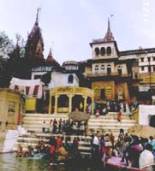
The Gaths
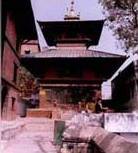
The Gaths
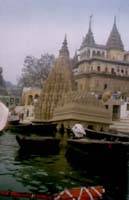
The Gaths
The temple of Durga
The temple of Durga was built in the 18th century in the Nagara style. It is nicknamed the monkey temple because of the presence of these animals. Goats are often sacrificed as an offering to the goddess. Non-Hindus may enter the court but not into the holy of holies.
The temple of Tulsi Manas
This marble temple is dedicated to Rama. It was built in 1964 at the place where the poet Tulsi wrote the Ramcharitmanas. The walls carry verses from the poem.
Le temple de Bharat Mata
It was inaugurated in 1936 by Mahatma Gandhi and dedicated to Mother India. It contains a map of India made of marble which would be on a scale, both horizontally and vertically.
The Hindu University
It is the largest and oldest university in North India. It was created in 1917 by Madan Mohan Malaviya. The university houses the Bharat Kala Bhavan Museum, which houses very fine collections of sculptures, paintings, manuscripts, etc ... including the Maurya period. It is also home to the new Vishwanath temple financed by the Birla family and open to all, regardless of caste or religion.
Ayodhya
Ayodhya is one of the seven holy cities of Hinduism as it is the hometown of Rama, the hero of the Ramayana. In the Atharvaveda we read that "Ayodhya was built by the gods." Many sanctuaries of all religions are scattered throughout the city. Buddhism, Jainism and Islam flourished in Ayodhya at different times. Unfortunately, in 1992, the equilibrium was broken by the Hindu fundamentalists who destroyed a mosque built on the presumed site of Rama's birthplace. This destruction caused a wave of violence in the country accompanied by terrorist attacks. Ayodhya is always under close surveillance.
The Ram Janam Bhumi
This small Hindu sanctuary was built after the destruction of the Babri Masjid mosque on December 6, 1992. The mosque was erected by the Mughals in the 15th century on the presumed site of Rama's birthplace. The Hindu nationalists used the pretext to claim the disappearance of the mosque. The federal government promised to rebuild a mosque and a Hindu temple, but since then it has been the status quo. Apart from its history, the present sanctuary is nothing extraordinary. If you decide to go there you will be searched and you will not be able to photograph anything.
The Hanumangadhi
Located in the center of the city, this temple was built by King Vikramaditya and dedicated to Hanuman, the monkey god. It is reached by a staircase of 76 steps. A surrounding wall was later built around the temple. The sanctuary houses the golden statue of Hanuman sitting on the knees of his mother Anjani.
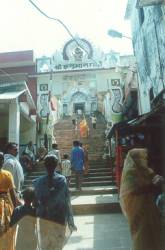
The Hanumangadhi
The Kanak Bhawan
It is one of the most important temples of Ayodhya. It contains the crowned statues of Rama, Sita and Lakshmana. The birth of Rama is celebrated in great pomp. Not far from the temple is a well whose faithful drink water.
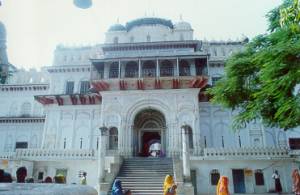
The Kanak Bhawan
The temple of Nageshwarnath
According to legend this temple was created by Kush, the son of Rama, for the woman he loved. A lingam is inside because Kush's beloved was a worshiper of Shiva . Offering water and milk to the lingam allows to fulfill the desires.
The Lakshmana Ghat
This ghat (Hindu ritual bathing place) is located on the banks of the Saryu River. Lakshmana is the brother of Rama. It is here that he would have recovered his divine nature.
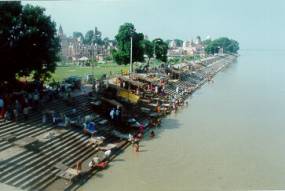
The Lakshmana Ghat
The Vashishtha Kund
According to legend the sage Vashishtha and his wife would have lived near this well with their cows. Bathing in the well allows one to reach the state of knowledge as Vashishtha.
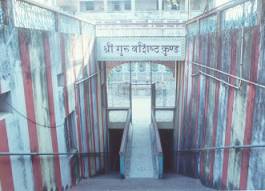
TheLakshmana Ghat
Sarnath
Sarnath is a great center of Buddhist pilgrimage. It is indeed here that Buddha would have made his first sermon to five disciples after having attained enlightenment.
Emperor Ashoka, who had converted to Buddhism, had many temples built at Sarnath in the 3rd century BC The city continued to grow until the arrival of the Muslims. The latter, in successive waves, destroyed the temples and monasteries. Sarnath remained abandoned until 1836, when the British excavated the ruins. Today Buddhist missions have come to Sarnath.
The Dhamekh Stupa
This stupa would rise to the place where Buddha pronounced his first sermon. 34 meters high and 43 meters wide at its base, the one visible today would be at least 1500 years old but excavations have shown that it would have been built instead of a stupa from the Maurya era (200 years before The stone part which surrounds the base of the stupa is decorated with floral and geometric friezes.
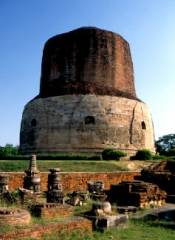
The Dhamekh Stupa
The Ashoka Column
It is located in the main sanctuary. It was erected to commemorate the visit of Emperor Ashoka to Sarnath. Originally it was 20 meters high but was amputated from its marquee. It is now visible in the archaeological museum of the city. It represents four leaned lions and served as a model for the emblem of the Indian Union.
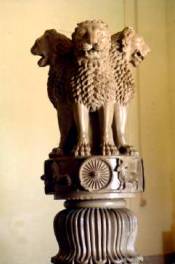
The Ashoka Column
The Mulgandha Kuti Vihar
This Buddhist sanctuary was built in 1931. It contains relics and a golden statue of Buddha. A big bell, gift from Japan, is at the entrance. The walls are decorated with delicate frescoes representing the life of Buddha. A "bodhi" tree was planted in the gardens. He would be the descendant of the tree under which the Buddha preached.
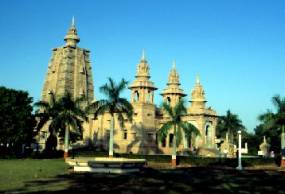
The Mulgandha Kuti Vihar
The Chaukhandi Stupa
This stupa, built during the Gupta period, was erected at the place where Buddha gathered his five disciples. Akbar added an octagonal tower to commemorate his father's visit to this place. The stupa is now dilapidated but we have a beautiful view from the top of the tower.
Rishikesh
Rishikesh is an important pilgrimage center on the banks of the Ganges. The city is home to many meditation centers and yoga schools that attract a lot of foreign tourists. In the 1960s the Beatles made a stay with their guru. Rishikesh is the starting point for pilgrims traveling to Garhwal-Badrinath, Kedarnath, Gangotri and Yamnotri.
The Bharat Mandir
It is the oldest temple in Rishikesh. It bears the name of Bharata, the brother of Rama, the hero of the Ramayana, but the divinity present in the temple is Narayana (ie Vishnu). The temple also contains many symbols for the cult of Shiva.
The Triveni Ghat
It is the main bathing place for the Hindu faithful. Hundreds of people who squeeze in every day make offerings of food to the river, which fatten the fish that live at the foot of the stairs! Every evening the faithful immerse oil lamps that drift on the river.
The Lakshman Jhula
The Lakshman Jhula is a suspension bridge that crosses the Ganges. He was baptized in honor of Lakshman, the brother of Rama because according to legend it is at this place that he would have crossed the river. The steel bridge replaced the rope bridge in 1929. Not far from the bridge is the Risha Kund, a well in which Rama and Lakshman bathed to purify themselves after the death of the Ravana demon.
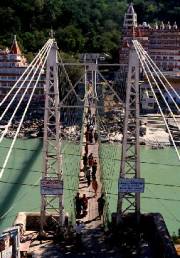
The Lakshman Jhula
The Nilkanth Mahadev Mela
This temple is located at 1675 m altitude. The road that leads to it offers superb panoramas of the region. The temple is dedicated to Nilkanth (another name Shiva).
Haridwar
Haridwar means Hari Gate, one of the names of Vishnu. It is here that the Ganges springs from the Himalayas to flow into the plains. Haridwar is one of the seven holy cities of Hinduism. Every twelve years is the Kumbh Mela (see Nasik for an explanation of the Kumbh Mela).
The town of Haridwar is very old. It is cited by Chinese travelers of the seventh century. It was sacked in 1399 by Tamerlane. In the 19th century it was an important center for religious reformist movements, notably the Arya Samaj.
The Ghat of Har Ki Pauri
The Hindus consider that the Ganges arises from the Himalayas precisely at this place. This sacred character is reinforced by the presence of a footprint of Vishnu on a stone. Many temples were built at the top of the ghat steps. The ashes of the dead are immersed here. Access to this ghat is allowed to non-Hindus but remain discreet.
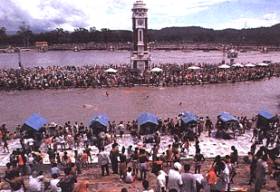
The Ghat of Har Ki Pauri
The Temple of Chandi Devi
This temple sits at the top of a hill south of Haridwar. It was built by the King of Kashmir, Suchat Singh, in 1929 and dedicated to the goddess Chandi. The statue of the goddess was erected by Adi Shankaracharya in the eighth century.
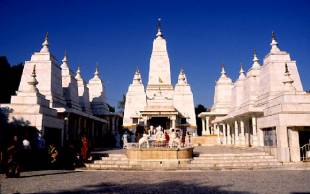
The Temple of Chandi Devi
The Temple of Manasa Devi
It was built on the hill overlooking the city. It is dedicated to the snake goddess Manasa, one of the forms of Durga. The ascent of the hill is done either on foot or by a chairlift. The view of the city and the Ganges valley is excellent.
The Bhimgoda Kund
The name of this well (kund) comes from Bhima, one of the five Pandava, hero of the Mahabharata, who would have dug it.
The Ashram of Sapt Rishi
Located five kilometers from Haridwar, the ashram is built on the banks of the Ganges. According to the legend the Ganges would have separated here in seven arms so as not to disturb the meditation of the seven Hindu sages (Rishi) who prayed there.
Corbett National Park
Corbett Park (named after a famous British hunter and naturalist) was the first national park in 1936. It now extends over 1318 km2. In 1973 he was chosen to set up the "Project Tiger" for the protection of tigers. In 1976 a dam was built, resulting in the formation of a lake and the implantation of many aquatic and migratory species. Located five hours from Delhi, it is the most famous park in India because of its biological diversity and its geographical location at the foot of the Himalayas. It is home to 350 species of mammals, 2000 species and subspecies of birds, 500 species of amphibians, reptiles and fish, 110 species of trees, 51 species of shrubs.
The reputation of the park has been built abroad on the presence of tigers even if it becomes more and more difficult to see. The best way to discover the park is by walking on the back of an elephant. You can rent a jeep at the entrance. The accompaniment of a guide is compulsory whatever your means of transport. You can stay inside the park in rest houses with spartan comfort (no electricity or very little) but also in luxurious hotels outside the park (very expensive). Please note that the rates charged for foreign visitors are much higher than for Indians.

Corbett National Park
See also:





